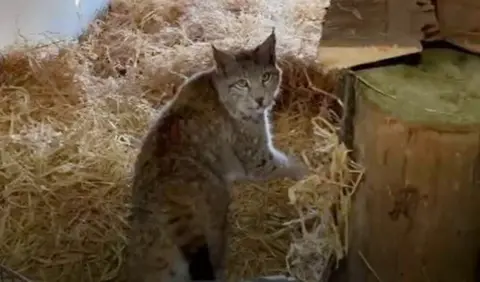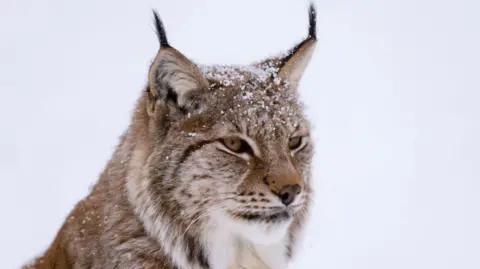The quest to catch the Cairngorms' mysterious lynx
 RZSS
RZSSOn the face of it, it seems a near-impossible task.
Catch one of the most elusive wild cat species, which has been set loose in a landscape twice the size of the Lake District National Park.
But this week experts were faced with this challenge not once, but twice.
Barely 24 hours after two escaped cats were captured in the Cairngorms, wildlife authorities were hot on the trail of two more after they were spotted in the same area.
This curious tale began on Wednesday night.
Police Scotland posted on social media a warning that two lynx had been spotted near Kingussie, a town of roughly 1,400 people, south of Aviemore.
The public were asked not to approach the animals if they encountered them.
A search was launched involving Royal Zoological Society of Scotland (RZSS) keepers from the nearby Highland Wildlife Park.
They were faced with a few challenges.
The Cairngorms National Park is the UK's biggest national park, sprawling across 1,748 sq miles and includes parts of five local authorities - Aberdeenshire, Angus, Highland, Moray and Perth and Kinross.
To put that in perspective, the Lake District National Park is about 912 sq miles, while the country of Luxembourg is less than 1,000.
It is a place of farms, crofts, forests and rugged hills, vast upland moors and mountains but few people. About 18,000 in total call the park home.
The cats were spotted near RSPB Scotland's Insh Marshes reserve, an area of wetlands and woods on the fringes of some of the Cairngorms' highest mountains.
It is also the depth of winter and it has been snowing - a lot - in the Scottish Highlands these past few weeks.
Then there are lynx themselves.
WWF describes them as solitary, elusive and nocturnal and rarely spotted by humans.
 Getty Images
Getty ImagesDespite these seemingly impossible odds, the two lynx were captured successfully on Thursday - just hours after they were spotted.
RZSS used cage-type traps baited with venison and quail, a small game bird.
The traps were fitted with doors that closed once the cats were inside.
The keepers were able to draw on their knowledge of keeping Northern lynx at the Highland Wildlife Park.
They also have past experience of collaring AWOL animals.
Last year, they captured a Japanese macaque that was on the loose for five days after escaping from the park.
Curiously, the lynx appeared to be far from elusive, but tame.
One sat looking back calmly as a headtorch was shone at it, and an RZSS keeper spoke to the lynx and it did not run away.
The pair are now in quarantine at Edinburgh Zoo.
The story was tailing off when on Friday morning Police Scotland dropped another post - two more lynx had been spotted in the same area.
A new search was launched involving police, RZSS, park rangers and Cairngorms Mountain Rescue Team drone.
They were captured later on Friday but on Saturday it was confirmed one of the lynx had died overnight.
Are the lynx dumped pets?
It is a still a mystery, though police are investigating.
A licence is required under the Dangerous Animals Act to keep lynx.
Local authority Highland Council said no premises in the area had applied for, or were operating under a Dangerous Wild Animal (DWA) licence, suggesting they had come from somewhere else.
Scotland's nature agency NatureScot also said it has not granted any licences for the reintroduction of lynx, a species once native to Britain before dying out hundred of years ago through habitat loss and hunting.
Do a quick internet search to find lynx wild cats to buy and there are links to sellers in the US, but not the UK.
A possible clue to where the "Cairngorms Four" originated from was reportedly found near where they were spotted.
BBC Scotland News understands bedding was discovered with porcupine quills in the straw.
Did whoever release the cats own other exotic animals?
Wildlife groups keen to see lynx one day roam free under legal reintroductions have been highly critical of lynx being let loose.
Lynx to Scotland, a three-charity partnership working to restore lynx to the Scottish Highlands, has raised serious concerns.
Peter Cairns, executive director of Scotland: The Big Picture, one of the charities involved, said: "The Lynx to Scotland Project is working to secure the return of lynx to the Scottish Highlands, and this illegal and grossly irresponsible act comes at the worst possible time, when stakeholders are engaging in good faith with productive discussions about the potential for a fully resourced legal reintroduction."
Any official reintroduction would likely involve 20 animals released in phases over eight years.
'It's caused a lot of anxiety'
BBC journalist Nicole Murray, who grew up in the area, said there had been a mixture of reactions from people.
She said: "Some are finding it very funny and saying 'first there was the monkey now this'.
"But also they are feeling really sorry for the poor animals.
"Locals are mainly just concerned with the welfare of the animals and wondering where they have come from.
"It has been bitterly cold this week."
Robert Macdonald, a local crofter and National Farmers' Union representative, said farmers were worried for their sheep and lambs.
He said he had spoken to farmers in Norway in recent times who had lost livestock to lynx.
Mr Macdonald said the illegal release in the Cairngorms had led farmers to bring their sheep to fields where it was easier to monitor them.
"It's caused a lot of anxiety," he said.
What else is on the loose in Scotland?
Lynx are just one of a number of animals to be illegally released, or escaped. Others include:
- Feral pigs - Forestry and Land Scotland and NatureScot believe there are a few thousand of them, with the largest numbers in the Highlands and South of Scotland
- Grey squirrels - A non-native species numbering as many as 200,000, according to Game & Wildlife Conservation Trust
- Non-native deer - It has been estimated there could be 10,000 sika and 1,000-2,000 fallow deer
